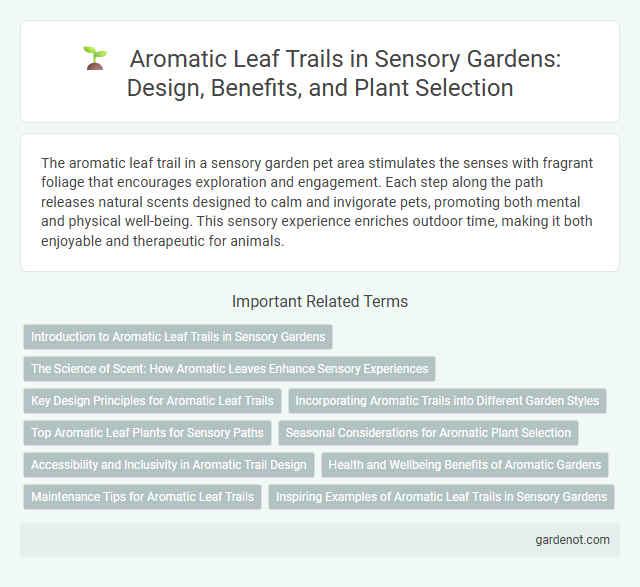The aromatic leaf trail in a sensory garden pet area stimulates the senses with fragrant foliage that encourages exploration and engagement. Each step along the path releases natural scents designed to calm and invigorate pets, promoting both mental and physical well-being. This sensory experience enriches outdoor time, making it both enjoyable and therapeutic for animals.
Introduction to Aromatic Leaf Trails in Sensory Gardens
Aromatic leaf trails in sensory gardens engage visitors through a variety of fragrant foliage carefully chosen to stimulate the olfactory senses. These trails feature plants such as lavender, rosemary, and mint, known for their distinct and therapeutic scents that enhance relaxation and mental well-being. Integrating aromatic leaf trails promotes interactive exploration, enriching the sensory experience while encouraging mindfulness and connection with nature.
The Science of Scent: How Aromatic Leaves Enhance Sensory Experiences
Aromatic leaves release volatile compounds that activate olfactory receptors, enhancing sensory perception through the brain's limbic system, which governs emotion and memory. Essential oils in leaves such as eucalyptus, mint, and lavender contain bioactive molecules that stimulate nerve endings, creating calming or invigorating effects on visitors. This biochemical interaction enriches the sensory garden experience by engaging multiple senses and promoting emotional well-being.
Key Design Principles for Aromatic Leaf Trails
Aromatic leaf trails integrate key design principles such as plant selection based on fragrance intensity and seasonal variation to enhance sensory engagement year-round. Pathways are designed with accessible widths and textures to encourage tactile interaction and ease of movement for all visitors. Strategic placement of aromatic plants along the trail ensures a layered olfactory experience, promoting relaxation and connection to nature.
Incorporating Aromatic Trails into Different Garden Styles
Incorporating aromatic leaf trails into various garden styles enhances sensory engagement by introducing fragrant foliage that stimulates olfactory senses. Mediterranean gardens benefit from aromatic herbs like lavender and rosemary, while Japanese Zen gardens emphasize subtle scents from plants such as mint and basil to promote mindfulness. Using native aromatic plants in formal or cottage gardens creates a cohesive environment that melds fragrance with visual appeal, enriching the overall sensory experience.
Top Aromatic Leaf Plants for Sensory Paths
Top aromatic leaf plants for sensory paths include lavender, rosemary, and mint, known for their strong, soothing fragrances that stimulate the olfactory senses. Lemon balm and sage also enhance sensory gardens with their crisp, refreshing scents and textured foliage, encouraging tactile exploration. Incorporating aromatic herbs like thyme and basil creates an immersive experience, blending vibrant scents with natural greenery to engage visitors fully.
Seasonal Considerations for Aromatic Plant Selection
Selecting aromatic plants for a sensory garden's leaf trail requires careful attention to seasonal variations in fragrance intensity and foliage appearance. Opt for a blend of evergreens like rosemary and seasonally vibrant herbs such as mint and lemon balm to ensure year-round aromatic interest. Incorporating plants that peak in different seasons guarantees a dynamic sensory experience, accommodating shifts in temperature and humidity that affect essential oil release.
Accessibility and Inclusivity in Aromatic Trail Design
The Aromatic Leaf Trail incorporates accessible pathways with smooth surfaces and gentle gradients to accommodate wheelchair users and individuals with mobility challenges. Plants are strategically placed at varying heights, allowing people of all ages and physical abilities to engage with diverse aromatic species through touch and scent. Inclusive design elements such as braille signage and sensory markers ensure that visually impaired visitors can fully experience the trail's fragrant environment.
Health and Wellbeing Benefits of Aromatic Gardens
The aromatic leaf trail in sensory gardens offers significant health and wellbeing benefits by stimulating the olfactory senses, which can reduce stress and enhance mood through natural aromatherapy. Exposure to aromatic plants like lavender, rosemary, and mint supports mental clarity, cognitive function, and emotional relaxation. Engaging with these sensory-rich environments promotes holistic wellness by combining nature's therapeutic properties with multisensory stimulation.
Maintenance Tips for Aromatic Leaf Trails
Regular pruning and removal of dead or diseased leaves ensures healthy growth and maximizes aromatic oil production along aromatic leaf trails. Consistent watering schedules maintain optimal soil moisture without waterlogging, promoting vibrant foliage and stronger scents. Mulching with organic material helps retain soil humidity and suppresses weeds, creating ideal conditions for aromatic plants to thrive.
Inspiring Examples of Aromatic Leaf Trails in Sensory Gardens
Aromatic leaf trails in sensory gardens showcase diverse plant species like lavender, rosemary, and mint, designed to stimulate olfactory senses while encouraging mindfulness and relaxation. Gardens such as the Royal Botanic Gardens in Melbourne and the Missouri Botanical Garden highlight aromatic pathways that blend native and exotic aromatic plants to enhance sensory experiences. These trails promote interactive learning and emotional well-being by inviting visitors to engage directly with fragrance-rich foliage throughout the garden.
Aromatic leaf trail Infographic

 gardenot.com
gardenot.com